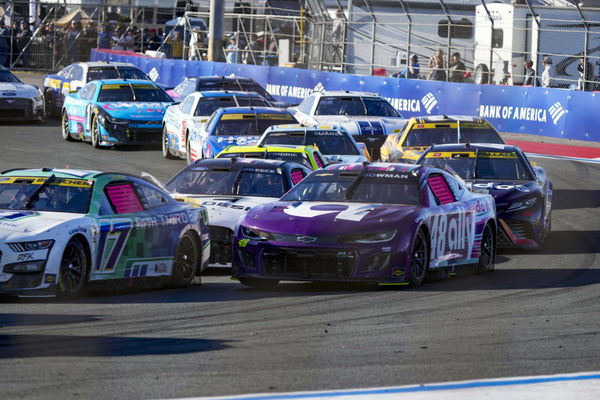
USA Today via Reuters
Oct 8, 2023; Concord, North Carolina, USA; Cars crowd into turn four after a restart during the Bank of America Roval 400 at Charlotte Motor Speedway Road Course. Mandatory Credit: Jim Dedmon-USA TODAY Sports

USA Today via Reuters
Oct 8, 2023; Concord, North Carolina, USA; Cars crowd into turn four after a restart during the Bank of America Roval 400 at Charlotte Motor Speedway Road Course. Mandatory Credit: Jim Dedmon-USA TODAY Sports
What makes NASCAR so interesting? Is it the roar of the V8 engine, all-out brawls in the pit lanes, or the uncertainty of race results? For most fans, the answer is all of the above. A big part of the sport’s appeal is its rawness, with drivers being able to make contact with each other on the track, which is not just accepted in certain circumstances but also celebrated.
However, if such contact were to go unchecked, races would be full of chaos, which is why drivers have been given the freedom to use their judgment on where to draw the line. That was until the Cup Series race at Richmond Raceway, where Austin Dillon’s controversial finish forced the sanctioning body to take matters into their own hands.
ADVERTISEMENT
Article continues below this ad
Jeff Burton believes NASCAR’s ‘line’ will always have some ambiguity
Austin Dillon was cruising in unchartered territory at Richmond Raceway. Having gone 68 races without a victory, the Richard Childress Racing driver had built a comfortable 3-second lead with just two laps to go at the Cook Out 400 before the controversy began. A crash between Ricky Stenhouse Jr and Ryan Preece forced a restart, and Dillon suddenly found himself in second place to Joey Logano, heading into the final corners. Unwilling to let go of his lead that easily, Dillon bumped into Logano’s No. 22 Ford Mustang, forcing him to crash into the wall. Denny Hamlin tried to capitalize on the opportunity on the exit of Turn 4, but Dillon was having none of it. The 34-year-old spun Hamlin, before being the first driver to get past the checkered flag.
Despite being awarded the race win, Dillon’s triumph at Richmond Raceway won’t give him a spot in the playoffs, as NASCAR’s Vice President of Competition, Elton Sawyer said, “We felt like, in this case, that the line was crossed.” But what exactly is the line? According to Jeff Burton, NASCAR analyst on NBC, the so-called grey area in stock car racing is hard to put into words. Speaking on Motorsports by NBC’s YouTube channel, ‘The Mayor’ said, “Well, the line is always difficult to explain, because unless NASCAR says ‘If you want to make contact with someone and they wreck, you’re going to be penalized’. Unless they say that, or even if they did say that, for that matter, because why did you hit? Maybe he lifted early, and you didn’t anticipate it, right? So you know, it’s actually easier in other series because they police it at a higher level. That’s not what NASCAR is. NASCAR, as Elton said after the race, has always been a contact sport. Some of the greatest moments in our sports’ history were guys wrecking each other. So what is that line?”

USA Today via Reuters
Feb 19, 2024; Daytona Beach, Florida, USA; NASCAR Cup Series drivers Austin Cindric (2), Chase Elliott (9) go low to avoid the crashing cars of Joey Logano (22), Daniel Suarez (99), Todd Gilliland (38), Brad Keselowski (6), Martin Truex Jr (19) and Ryan Blaney (12) during the Daytona 500 at Daytona International Speedway. Mandatory Credit: Mark J. Rebilas-USA TODAY Sports
If there is one clear thing, it’s that NASCAR’s ‘line’ is open to interpretation. The sanctioning body has created a playoff format that rewards winning races, no matter what the context may be. In Austin Dillon’s case, the Richard Childress Racing driver was in a distant 32nd place in the driver standings, and his only hope to make it into the playoffs was through a win. When the opportunity presented itself, the 34-year-old took it with both hands, even if that meant it came at the expense of Joey Logano and Denny Hamlin. Both the victims have won races by hitting drivers in front of them in the past. The only difference is they didn’t take out two drivers at the same time on the same turn. That’s where NASCAR draws the line, it seems.
Dillon’s punishment was inevitable, as letting the incident go without repercussions would have set a dangerous precedent. The sanctioning body was put in a position where they had to decide between drawing a line or having no line at all, and they chose to do the former. However, the verdict came three days too late, even if it meant that the Richard Childress Racing driver was docked 25 points and his spotter, Brandon Benesch, was suspended for three races. While NASCAR still has a long way to go to streamline these decisions and eliminate the ambiguity in what constitutes ‘crossing the line’, it’s refreshing to see that the organization made the right verdict, even if it came with a delay.
ADVERTISEMENT
Article continues below this ad
Trending
What’s your perspective on:
Are NASCAR's 'grey areas' ruining the sport, or are they just part of the game?
Have an interesting take?
How is NASCAR changing its approach towards on-track incidents?
Gone are the days when NASCAR had a devil-may-care outlook toward reckless driving. While the sanctioning body would be better off if they laid out clear-cut guidelines regarding just how much crashing is allowed, drivers, team owners, and fans have seen a shift in approach when it comes to their tolerance towards on-track incidents. Bubba Wallace was suspended for a race in 2022 after a mix-up with Kyle Larson on Lap 94 of the South Point 400 while Chase Elliott received a similar punishment for intentionally wrecking Denny Hamlin at Charlotte Motor Speedway.
This season, Carson Hocevar was fined $50,000 and docked 25 points for intentionally spinning Harrison Burton under caution at the Ally 400 while Layne Riggs was issued a two-lap penalty for reckless driving after spinning Stefan Parsons in the Truck Series. While NASCAR’s ruling on Dillon’s race victory is the most high-profile one yet, it’s sending a clear-cut message that intentional crashes will be subjected to a post-race review. While it’s a step in the right direction, most fans will hope that this approach will extend to the races themselves soon, so that there isn’t a three-day delay in NASCAR’s verdict.
ADVERTISEMENT
Article continues below this ad
In the longer term, the organization would be best suited to having clearer guidelines about what is and isn’t acceptable on track. In an era where safety is of paramount importance, limiting the amount of judgment calls from drivers, especially with on-track incidents would be in the best interest of all involved. Grey areas in any sport are open to interpretation and subject to being inconsistently applied. While the sport evolves, it’s time the rules governing it adapt as well.
What are your thoughts about Austin Dillon’s final lap at Richmond Raceway? Let us know in the comments!
ADVERTISEMENT
ADVERTISEMENT
ADVERTISEMENT
ADVERTISEMENT


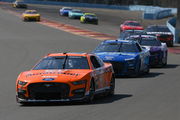
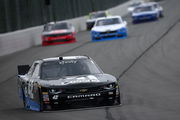
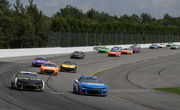
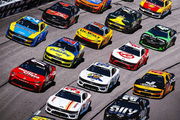

Are NASCAR's 'grey areas' ruining the sport, or are they just part of the game?